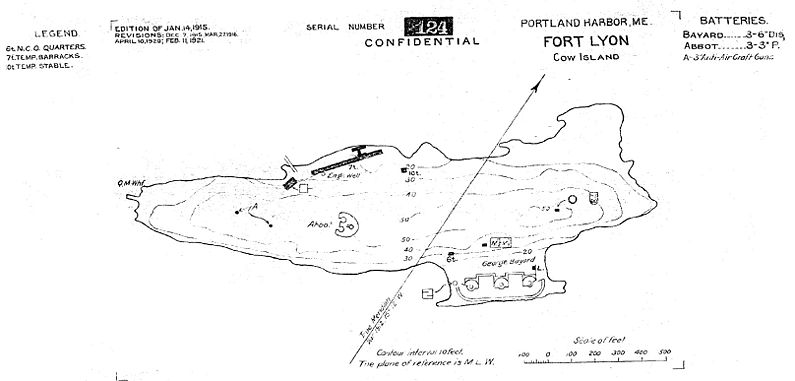Fort Lyon (1)
|
Fort Lyon (1) (1896-1946) - An Endicott Period Coastal Fort first established in 1896, as a sub post of Fort McKinley, on Cow Island, Cumberland County, Maine. Named Fort Lyon in G.O. 194, 27 Dec 1904, after Brigadier General Nathaniel Lyon, U.S. Volunteers (Captain 2nd U.S. Infantry), who served during the Mexican-American War and the U.S. Civil War, and who was killed in action at the Battle of Wilson's Creek, Missouri, 10 Aug 1861. Turned over to the city of Portland, Maine, in 1946. Assigned Location ID ME00093. Endicott Period (1890-1910)Part of the Harbor Defense of Portland, Maine. Fort Lyon was built on 22 acres of Cow Island, Cumberland County, Maine. The whole island was acquired by the government in 1873. Two Endicott Period gun batteries were built on Fort Lyon, Battery Bayard was accepted for service on 27 Dec 1907 and Battery Abbot was accepted for service on 29 Jan 1909. A Double M" Station (29 Jan 1909) and a Searchlight Observing Station (6 May 1911) were also located on the island. Fort Lyon operated as a sub-post of Fort McKinley, and much of the time was in caretaker status. A single set of NCO quarters was constructed on the island in 1907 to house an ordnance sergeant caretaker. Freshwater was furnished to the post via an underwater pipe from Fort McKinley except during the winter when it was turned off. A small well was used during the winter. A latrine and lavatory was constructed at the rear of Battery Bayard and accepted for service 11 Aug 1908 at a cost of $1,072.82.

World War I (1917-1918)In late 1917 Battery Bayard was deactivated and the three gun tubes dismounted and transferred to Watervliet for conversion to a mobile configuration. All three of these guns were sent to France, returned to the U.S. after the war and reused later in World War II gun batteries. Battery Bayard was not rearmed. Three temporary buildings were constructed by post labor in 1917, including a 20' by 325' barracks, a 14' by 63' lavatory and a 20' by 24' stable. The Fort capacity was 85 men and 5 animals. The temporary World War I barracks and lavatory were salvaged in 1922. World War II (1941-1945)Fort Lyon expanded significantly just before the start of World War II, adding three new temporary buildings and utilities to house 130 enlisted men and 6 officers. The three buildings included a 172 man mess hall, a 74 man enlisted barracks and a modified barracks to house 56 enlisted men and 6 officers. The contractor was given two months, November and December 1941, to complete the work which included a new wharf, streets, and utilities. The total cost came to $ 182,848.00. During World War II, Battery Abbot and antiaircraft battery #3 were active on Fort Lyon. The post was deactivated after the end of the war and transferred to the city of Portland, Maine, in 1946. Current StatusPrivate property on Cow Island, Cumberland County, Maine.
Sources:
Links: Visited: No | ||||||||||||||||||||||||||||||